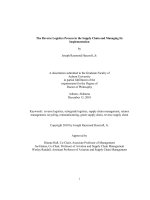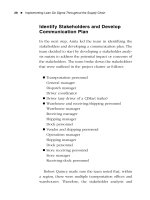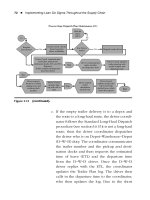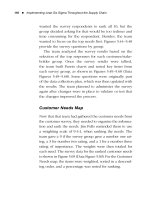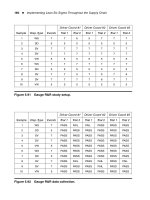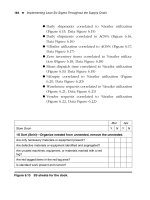Operation management in the supply chain decision and case 7th schroeder
Bạn đang xem bản rút gọn của tài liệu. Xem và tải ngay bản đầy đủ của tài liệu tại đây (18.26 MB, 524 trang )
SEVENTH EDITION
Operations Management
in the Supply Chain
DECISIONS AND CASES
Roger Schroeder | Susan Meyer Goldstein
Operations
Management in the
Supply Chain
Decisions and Cases
The McGraw-Hill Education Series Operations and Decision Sciences
OPERATIONS MANAGEMENT
Beckman and Rosenfield
Operations Strategy: Competing in the
21st Century
First Edition
Benton
Purchasing and Supply Chain
Management
Third Edition
Bowersox, Closs, and Cooper
Supply Chain Logistics Management
Fifth Edition
Brown and Hyer
Managing Projects: A Team-Based
Approach
Second Edition
Burt, Petcavage, and Pinkerton
Supply Management
Ninth Edition
Cachon and Terwiesch
Operations Management
First Edition
Cachon and Terwiesch
Matching Supply with Demand: An
Introduction to Operations Management
Fourth Edition
Finch
Interactive Models for Operations and
Supply Chain Management
First Edition
Fitzsimmons and Fitzsimmons
Service Management: Operations,
Strategy, Information Technology
Eighth Edition
Gehrlein
Operations Management Cases
First Edition
Harrison and Samson
Technology Management
First Edition
Hayen
SAP R/3 Enterprise Software: An
Introduction
First Edition
Hill
Manufacturing Strategy:
Text & Cases
Third Edition
Hopp
Supply Chain Science
First Edition
Hopp and Spearman
Factory Physics
Third Edition
Simchi-Levi, Kaminsky,
and Simchi-Levi
Designing and Managing the
Supply Chain: Concepts, Strategies,
Case Studies
Third Edition
Sterman
Business Dynamics: Systems
Thinking and Modeling for a
Complex World
First Edition
Stevenson
Operations Management
Twelfth Edition
Jacobs, Berry, Whybark, and Vollmann
Manufacturing Planning & Control for
Supply Chain Management
Sixth Edition
Swink, Melnyk, Cooper,
and Hartley
Managing Operations Across
the Supply Chain
Third Edition
Jacobs and Chase
Operations and Supply Chain
Management
Fourteenth Edition
Thomke
Managing Product and Service
Development: Text and Cases
First Edition
Jacobs and Chase
Operations and Supply Chain
Management: The Core
Fourth Edition
Ulrich and Eppinger
Product Design and
Development
Sixth Edition
Jacobs and Whybark
Why ERP?
First Edition
Zipkin
Foundations of Inventory
Management
First Edition
Johnson, Leenders, and Flynn
Purchasing and Supply
Management
Fifteenth Edition
QUANTITATIVE METHODS AND
MANAGEMENT SCIENCE
Larson and Gray
Project Management: The Managerial
Process
Sixth Edition
Hillier and Hillier
Introduction to Management Science: A
Modeling and Case Studies Approach
with Spreadsheets
Fifth Edition
Schroeder and Goldstein
Operations Management in the Supply
Chain: Decisions and Cases
Seventh Edition
Stevenson and Ozgur
Introduction to Management Science
with Spreadsheets
First Edition
Operations
Management in the
Supply Chain
Decisions and Cases
Seventh Edition
Roger G. Schroeder
Susan Meyer Goldstein
Carlson School of Management
University of Minnesota
OPERATIONS MANAGEMENT IN THE SUPPLY CHAIN: DECISION AND CASES, SEVENTH EDTION
Published by McGraw-Hill Education, 2 Penn Plaza, New York, NY 10121. Copyright © 2018 by McGraw-Hill
Education. All rights reserved. Printed in the United States of America. Previous editions © 2013, 2011,
and 2008. No part of this publication may be reproduced or distributed in any form or by any means, or stored in
a database or retrieval system, without the prior written consent of McGraw-Hill Education, including, but not
limited to, in any network or other electronic storage or transmission, or broadcast for distance learning.
Some ancillaries, including electronic and print components, may not be available to customers outside the
United States.
This book is printed on acid-free paper.
1 2 3 4 5 6 7 8 9 LWI 21 20 19 18 17
ISBN978-0-07-783543-9
MHID0-07-783543-3
Chief Product Officer, SVP Products & Markets: G. Scott Virkler
Vice President, General Manager, Products & Markets: Marty Lange
Managing Director: James Heine
Brand Manager: Dolly Womack
Product Developer: Camille Corum
Marketing Manager: Britney Hermsen
Director, Content Design & Delivery: Linda Avenarius
Program Manager: Mark Christianson
Content Project Managers: Melissa M. Leick, Bruce Gin, Timothy Cote
Buyer: Laura Fuller
Design: Studio Montage, Inc.
Content Licensing Specialists: Beth Thole
Cover Image: © David Vernon/E+/Getty Images
Compositor: Aptara®, Inc.
Printer: LSC Communications
All credits appearing on page or at the end of the book are considered to be an extension of the copyright page.
Library of Congress Cataloging-in-Publication Data
Schroeder, Roger G., author. | Goldstein, Susan Meyer, author. |
Operations management in the supply chain : decisions and cases /
Roger G. Schroeder, Susan Meyer Goldstein, Carlson School of Management,
University of Minnesota.
Operations management
Seventh edition. | Dubuque : McGraw-Hill Education, 2016.
LCCN 2016043564 | ISBN 9780077835439 (alk. paper) |
ISBN 0077835433 (alk. paper)
LCSH: Production management. | Production management—Case studies. |
Decision making.
LCC TS155 .S334 2016 | DDC 658.5—dc23 LC record available at />The Internet addresses listed in the text were accurate at the time of publication. The inclusion of a website does
not indicate an endorsement by the authors or McGraw-Hill Education, and McGraw-Hill Education does not
guarantee the accuracy of the information presented at these sites.
mheducation.com/highered
To our families, whose encouragement and love we appreciate
—Roger G. Schroeder
—Susan Meyer Goldstein
About the Authors
Roger G. Schroeder
is the Frank A. Donaldson Chair in Operations Management Emeritus at the Curtis L.
Carlson School of Management, University of Minnesota. He received a B.S. degree in
Industrial Engineering with high distinction and a MSIE degree from the University of
Minnesota, and a Ph.D. from Northwestern University. He held positions in the Carlson
School of Management as Director of the Ph.D. program, Chair of the Operations and
Management Science Department, and Co-Director of the Joseph M. Juran Center for
Leadership in Quality. Professor Schroeder has obtained research grants from the National
Science Foundation, the Ford Foundation, and the American Production and Inventory
Control Society. His research is in the areas of quality management, operations strategy,
and high-performance manufacturing, and he is among the most widely published and
cited researchers in the field of operations management. He has been selected as a member
of the University of Minnesota Academy of Distinguished Teachers and is a recipient of
the Morse Award for outstanding teaching. Professor Schroeder received the lifetime
achievement award in operations management from the Academy of Management, and he
is a Fellow of the Decision Sciences Institute and a Fellow of the Production and Operations Management Society. Professor Schroeder has consulted widely with numerous organizations, including 3M, Honeywell, General Mills, Motorola, Golden Valley Foods, and
Prudential Life Insurance Company.
Susan Meyer Goldstein
is Associate Professor in the Supply Chain and Operations Department at the Curtis L.
Carlson School of Management, University of Minnesota. She earned a B.S. degree in
Genetics and Cell Biology and an M.B.A. at the University of Minnesota and worked in the
health care industry for several years. She later obtained a Ph.D. in operations management
from Fisher College of Business at The Ohio State University. She has served on the
faculty at the University of Minnesota since 1998 and was a Visiting Professor at the Olin
Business School at Washington University in St. Louis for two years. Her current research
investigates the link between service process design and process performance, and she is
currently working with a Minnesota hospital that has been achieving one of the lowest
heart attack mortality rates in the United States. She is also interested in issues related to
aging service workers, operations strategy, and service quality. Her research has been published in Decision Sciences, Journal of Operations Management, and Production and
Operations Management, among others. She is Associate Editor at Decision Science
Journal, Quality Management Journal, and Service Industries Journal and serves on the
editorial boards of many operations and service journals. She is the recipient of several
research awards and research grants, and received the 2011 Carlson School of Management
Teaching Award.
vi
Preface
FEATURES
Operations management is an exciting and vital field in today’s complex business world.
Therefore, students in both MBA and undergraduate courses have an urgent need to understand operations—an essential function in every business.
This textbook on operations management in the supply chain emphasizes decision making in operations with a supply chain orientation. The text provides materials of interest to
general business students and operations and supply chain management majors. By stressing cross-functional decision making, the text provides a unique and current business perspective for all students. This is the first text to incorporate cross-functional decision
making in every chapter.
A unique decision framework organizes the material by grouping decisions into five
major categories: process, quality, capacity, inventory, and supply chain. This framework is
intended to make it easy for students to understand the decision role and responsibilities of
operations and supply chain management in relation to functions such as marketing and
finance. See the illustration below. The text also provides a balanced treatment of both
service and manufacturing firms. We continue to emphasize operations in the supply chain
with new chapters on sourcing and logistics.
The most current knowledge is incorporated, including global operations, supply chain
management, e-operations, service blueprinting, competency-based strategy, Six Sigma, lean
systems, 3D printing, sustainability, supply chain risk, and mass customization. Complete
coverage is also provided on traditional topics, including process design, service systems,
quality management, ERP, inventory control, and scheduling.
While covering the concepts of operations and supply chain management in 18 chapters,
the book also provides 18 case studies. The cases are intended to strengthen problem formulation skills and illustrate the concepts presented in the text. Long and short case studies
are included. The cases are not just large problems or examples; rather, they are substantial
management case studies, including some from the Northwestern, Sheffield, Cranfield,
and The Case Centre collections.
The softcover edition with fewer pages than most introductory books covers all the
essentials students need to know about operations management in the supply chain, leaving
out only superfluous and tangential topics. By limiting the size of the book, we have
condensed the material to the basics. The book is also available for the first time in digital
formats in Connect and LearnSmart versions.
Decision-making
framework for
operations in the
supply chain.
Human
Resources
Suppliers
Supply
Chain
Decisions
Finance
Process
Inventory
Information
Systems
Quality
Marketing
Customers
Capacity
Accounting
vii
viii
Preface
This book is ideal for regular operations management courses and also case courses and
modular courses. It is particularly useful for those who desire a cross-functional and
decision-making perspective that reaches across the supply chain. Instructors can easily
supplement the text with their own cases, readings, or course materials as desired.
The Connect Library and Instructor Resources contain 20 Excel templates designed to
assist in solving problems at the end of chapters and the case studies. These resources also
contain technical chapters on linear programming, simulation, transportation method, and
queuing, which can be assigned by the instructor, if desired. The resources have PowerPoint slides, solutions manual, the test bank, and web links to companies cited in the Student Internet Exercises in the text. Access to these web resources can be obtained from
your McGraw-Hill sales representative or directly in the Connect Library.
A number of pedagogical features are contained in this book.
x
e cel
∙ Operations Leader boxes are included in each chapter to illustrate current practices
being implemented by leading firms.
∙ Each chapter contains at least three Student Internet Exercises. These exercises allow
for extended learning about concepts discussed in the chapter.
∙ Points of cross-functional emphasis are noted in each chapter by a special symbol—a
handshake. This highlights the locations of cross-functional aspects of operations
decisions.
∙ Solved problems are included at the end of quantitative chapters to provide additional examples for students.
∙ Excel spreadsheets are keyed to specific problems at the end of chapters.
KEY CHANGES IN THE SEVENTH EDITION
This book is known for its decision orientation and case studies. We have strengthened the
decision-making framework by addressing new decisions in sourcing, logistics, sustainability, and global supply chains. We also added new cases to address these decisions.
1. Supply Chain Management. This edition added a new section on Supply
Chain. It contains two new chapters on Sourcing and Global Logistics. The Sourcing
chapter contains material on sourcing goals, outsourcing, offshoring, reshoring, supply
base optimization, the purchasing cycle, and scorecard weighting. The Global Logistics chapter contains material on the role of logistics, transportation modes, distribution centers, logistics networks, location, third-party logistics, and logistics strategy. In
addition, the Supply Chain Management chapter was moved to this section and updated to add a new section on supply chain risk and another new section on supply
chain sustainability. This edition now has the latest and best supply chain material
available.
2. Sustainability. More emphasis is given to sustainability. It is now covered in the c hapters
on The Operations Function, Operations and Supply Chain Strategy, Process Selection, and
Supply Chain Management. A new case study is added on Murphy Warehouse: Sustainable
Logistics.
3. Global. More material is provided on global operations and supply chains. With the
addition of the Sourcing and Global Logistics chapters, global emphasis now moves
beyond operations to the entire supply chain. New material on outsourcing, offshoring, and
managing global supply chains has been added. New cases on global sourcing, global plant
location, and global logistics are added.
Preface
ix
4. Other Additions. We have added materials on lean Six Sigma, 3D Printing, big
data, analytics, ethics in sourcing, and disaster logistics.
5. Digital Versions. Digital versions of the text in McGraw-Hill’s Connect and
LearnSmart have been developed. The Connect version provides a complete course management system for the instructor and pdf content for students. It can be used to customize
the course by selecting learning objectives for course coverage, using the test bank for
multiple choice questions, automatic grading for selected quantitative problems, and access
to all instructor support materials. The LearnSmart version provides feedback to students
via multiple choice probes for each learning objective. The student is directed to return to
readings where retention is weak.
6.
Cases. Eighteen case studies are provided including cases from The Case Centre,
and Northwestern, Sheffield, and Cranfield Universities. Existing cases have been revised
to add current information. Ten new cases are added:
Altimus Brands: Managing Procurement Risk;
Murphy Warehouse Company: Sustainable Logistics;
Polaris Industries Inc.—Global Plant Location;
Shelter Box: A Decade of Disaster Relief;
The Westerfield Physician Practice: Value Stream Mapping;
Journey to Perfect: Mayo Clinic and the Path to Quality;
The Evolution to Lean Six Sigma in 3M, Inc.;
Sage Hill Above Onion Creek: Focusing on Service Process and Qualilty;
Toledo Custom Manufacturing: Quality Control;
Best Homes: Forecasting
INSTRUCTOR RESOURCES
Instructor Resource Center www.mhhe.com/schroeder7e
The Instructor Resource Center provides complete materials for study and review. At this
book’s website, instructors have access to teaching support such as electronic files of the
ancillary materials: Solutions Manual, Technical Chapters, Excel Spreadsheets, PowerPoint Lecture Slides, Digital Image Library, and Test Bank.
Solutions Manual. Prepared by the authors, this manual contains solutions to all the
end-of-chapter problems and cases.
Test Bank. The Test Bank includes true/false, multiple-choice, and discussion questions/
problems at varying levels of difficulty.
EZ Test Online. All test bank questions are available in EZ Test Online, a flexible electronic testing program. The answers to all questions are given, along with a rating of the
level of difficulty, chapter learning objective met, Bloom’s taxonomy question type, and
the AACSB knowledge category.
PowerPoint Lecture Slides. The PowerPoint slides draw on the highlights of each chapter
and provide an opportunity for the instructor to emphasize the key concepts in class discussions.
Digital Image Library. All the figures in the book are included for insertion in PowerPoint slides or for class discussion.
x
Preface
Excel Spreadsheets. Twenty Excel Spreadsheets are provided for students to solve designated problems at the end of chapters.
Technical Chapters. Four technical chapters are provided for additional technical material on linear programming, transportation method, simulation and waiting lines.
Operations Management Video Series
The operations management video series, free to text adopters, includes professionally developed videos to help students fully understand the content and terminology within
Operations and Supply Chain Management. These videos will be both relevant and up-todate in order to be effectively utilized. Each video will come with a series of questions to
assess the students’ knowledge of the material.
TECHNOLOGY
McGraw-Hill Connect® Operations Management
McGraw-Hill Connect® Operations Management is an online assignment and assessment
solution that connects students with the tools and resources they’ll need to achieve success
through faster learning, higher retention, and more efficient studying. It provides instructors with
tools to quickly pick content and assignments according to the topics they want to emphasize.
Online Assignments. Connect Operations Management helps students learn more efficiently
by providing practice material and feedback when they are needed. Connect grades homework
automatically and provides feedback on any questions that students may have missed.
LearnSmart. LearnSmart adaptive self-study technology with Connect Operations
Management helps students make the best use of their study time. LearnSmart provides
a seamless combination of practice, assessment, and remediation for every concept in the
textbook. LearnSmart’s intelligent software adapts to students by supplying questions on a
new concept when students are ready to learn it. With LearnSmart students will spend less
time on topics they understand and instead focus on the topics they need to master.
Simple Assignment Management and Smart Grading. When it comes to studying,
time is precious. Connect Operations Management helps students learn more efficiently by
providing feedback and practice material when they need it, where they need it. When it
comes to teaching, your time also is precious. The grading function enables you to:
∙ Have assignments scored automatically, giving students immediate feedback on their
work and side-by-side comparisons with correct answers.
∙ Access and review each response; manually change grades or leave comments for students to review.
Student Reporting. Connect Operations Management keeps instructors informed about
how each student, section, and class is performing, allowing for more productive use of
lecture and office hours. The progress-tracking function enables you to:
∙ View scored work immediately (Add Assignment Results Screen) and track individual
or group performance with assignment and grade reports.
∙ Access an instant view of student or class performance relative to learning objectives.
∙ Collect data and generate reports required by many accreditation organizations, such
as AACSB.
Preface
xi
Instructor Library. The Connect Operations Management Instructor Library is your
repository for additional resources to improve student engagement in and out of class.
You can select and use any asset that enhances your lecture. The Connect Operations
Management Instructor Library includes:
∙
∙
∙
∙
∙
∙
∙
eBook
PowerPoint presentations
Test Bank
Instructor’s Solutions Manual
Digital Image Library
Excel Spreadsheets
Technical Chapters
Integrated Media-Rich eBook. An integrated media-rich eBook allows students to
access media in context with each chapter. Students can highlight, take notes, and access
shared instructor highlights/notes to learn the course material.
Dynamic Links. Dynamic links between the problems or questions you assign to your
students and the location in the eBook where that problem or question is covered.
Tegrity Campus: Lectures 24/7
Tegrity Campus is a service that makes class time available 24/7 by automatically capturing every lecture in a searchable format for students to review when they study and
complete assignments. With a simple one-click start-and-stop process, you capture all
computer screens and corresponding audio. Students can replay any part of any class with
easy-to-use browser-based viewing on a PC or Mac.
Educators know that the more students can see, hear, and experience class resources,
the better they learn. In fact, studies prove it. With Tegrity Campus, students quickly recall
key moments by using Tegrity Campus’s unique search feature. This search helps students efficiently find what they need, when they need it, across an entire semester of class
recordings. Help turn all your students’ study time into learning moments immediately
supported by your lecture. To learn more about Tegrity, watch a two-minute Flash demo at
.
Online Course Management
No matter what online course management system you use (WebCT, BlackBoard, or eCollege),
we have a course content ePack available for your course. Our new ePacks are specifically
designed to make it easy for students to navigate and access content online. For help, our online
Digital Learning Consultants are ready to assist you with your online course needs. They provide training and will answer any questions you have throughout the life of your adoption.
McGraw-Hill Higher Education and Blackboard have teamed up. What does this mean for you?
1. Single sign-on. Now you and your students can access McGraw-Hill’s Connect and
Create right from within your Blackboard course-all with one single sign-on.
2. Deep integration of content and tools. You get a single sign-on with Connect and Create,
and you also get integration of McGraw-Hill content and content engines right into Blackboard. Whether you’re choosing a book for your course or building Connect assignments,
all the tools you need are right where you want them-inside of Blackboard.
3. One gradebook. Keeping several gradebooks and manually synchronizing grades into
Blackboard is no longer necessary. When a student completes an integrated Connect
xii
Preface
assignment, the grade for that assignment automatically (and instantly) feeds your
Blackboard grade center.
4. A solution for everyone. Whether your institution is already using Blackboard or you
just want to try Blackboard on your own, we have a solution for you. McGraw-Hill and
Blackboard can now offer you easy access to industry-leading technology and content,
whether your campus hosts it, or we do. Be sure to ask your local McGraw-Hill representative for details.
ASSURANCE OF LEARNING READY
Many educational institutions today are focused on the notion of assurance of learning, an
important element of some accreditation standards. Operations Management in the Supply
Chain, 7e is designed specifically to support your assurance of learning in initiatives with
a simple yet powerful solution.
Instructors can use Connect to easily query for learning outcomes/objectives that directly relate to the learning objectives of the course. You can then use the reporting features of Connect to aggregate student results in similar fashion, making the collection and
presentation of assurance of learning data simple and easy.
AACSB STATEMENT
McGraw-Hill Global Education is a proud corporate member of AACSB International.
Understanding the importance and value of AACSB accreditation, the authors of Operations Management in the Supply Chain, 7e have sought to recognize the curricula guidelines detailed in the AACSB standards for business accreditation. By connecting questions
in the test bank and end-of-chapter material to the general knowledge and skill guidelines
found in the AACSB standards.
It is important to note that the statements contained in Operations Management in the
Supply Chain, 7e are provided only as a guide for the users of this textbook. The AACSB
leaves content coverage and assessment within the purview of individual schools, the mission of the school, and the faculty. While Operations Management in the Supply Chain, 7e
and the teaching package make no claim of any specific AACSB qualification or evaluation, we have within Operations Management in the Supply Chain, 7e labeled selected
questions according to the general knowledge and skills areas.
MCGRAW-HILL CUSTOMER CARE CONTACT INFORMATION
At McGraw-Hill, we understand that getting the most from new technology can be challenging. That’s why our services don’t stop after you purchase our products. You can
e-mail our Product Specialists 24 hours a day to get product-training online. Or you can
search our knowledge bank of Frequently Asked Questions on our support website. For
Customer Support, call 800-331-5094, e-mail , or visit www.
mhhe.com/support. One of our Technical Support Analysts will be able to assist you in a
timely fashion.
Preface
xiii
ACKNOWLEDGMENTS
The authors would like to acknowledge the many individuals who have assisted with this
book. Special thanks go to the reviewers for this edition:
Tobias Stapleton
University of Massachusetts—Dartmouth
Richard C. Yokeley
Forsyth Technical Community College
Ralph James Rich
Marian University
Rajkumar Kempaiah
College of Mount Saint Vincent
Thomas Buchner
University of Minnesota
Chris D. Bellamy
Eastern University
Pradip K. Shukla
Chapman University
Marvin E. Gonzalez
College of Charleston
Gerald T. Pineault
Lasell College
Jeffrey William Fahrenwald
Rockford University
William M. Penn
Belhaven University
Jeryl L. Nelson
Wayne State College
Clarke W. Higgins
Chapman University
Jay Zortman
Eastern University
Deborah L. Piscitiello
University of Jamestown
Charles Vincent Nemer
Metropolitan State University
Kenneth E. Murphy
Chapman University
Kathy Schaefer
Southwest Minnesota State
University
Nancy Levenburg
Grand Valley State University
Tyler M. Moore
Marian University
Steven Williams
Marian University
The authors would also like to thank the staff at McGraw-Hill Education who had a direct
hand in the editing and production of the text.
We would like to thank our colleagues at the University of Minnesota who listened to our
ideas and provided suggestions for book improvement. Additional thanks go to Doug and
Letty Chard, who diligently and carefully prepared the index. We would also like to thank
Tom Buchner of the University of Minnesota who carefully prepared the test bank questions. Our thanks to Ed Pappanastos of Troy University for constructing the Connect solutions to problems. Finally, we thank our families for their patience and perseverance during
the many months of writing and editing. Without their support and encouragement this
textbook would not have been possible.
Roger G. Schroeder
Susan Meyer Goldstein
®
Required=Results
©Getty Images/iStockphoto
McGraw-Hill Connect®
Learn Without Limits
Connect is a teaching and learning
platform that is proven to deliver better
results for students and instructors.
Connect empowers students by
continually adapting to deliver precisely
what they need, when they need it, and
how they need it, so your class
time is more engaging and effective.
73% of instructors who use
Connect require it; instructor
satisfaction increases by 28%
when Connect is required.
Using Connect improves passing rates
by 12.7% and retention by 19.8%.
Analytics
Connect Insight®
Connect Insight is Connect’s new one-of-a-kind
visual analytics dashboard—now available for both
instructors and students—that provides at-a-glance
information regarding student performance, which is
immediately actionable. By presenting assignment,
assessment, and topical performance results together with
a time metric that is easily visible for aggregate or individual
results, Connect Insight gives the user the ability to take a
just-in-time approach to teaching and learning, which was
never before available. Connect Insight presents data that
empowers students and helps instructors improve class
performance in a way that is efficient and effective.
Students can view
their results for any
Connect course.
Adaptive
THE ADAPTIVE
READING EXPERIENCE
DESIGNED TO TRANSFORM
THE WAY STUDENTS READ
©Getty Images/iStockphoto
More students earn A’s and B’s
when they use McGraw-Hill Education
Adaptive products.
SmartBook®
Proven to help students improve grades and study
more efficiently, SmartBook contains the same
content within the print book, but actively tailors
that content to the needs of the individual.
SmartBook’s adaptive technology provides
precise, personalized instruction on what the
student should do next, guiding the student to
master and remember key concepts, targeting
gaps in knowledge and offering customized
feedback, and driving the student toward
comprehension and retention of the subject
matter. Available on smartphones and tablets,
SmartBook puts learning at the student’s
fingertips—anywhere, anytime.
Over 5.7 billion questions have
been answered, making McGraw-Hill
Education products more intelligent,
reliable, and precise.
www.mheducation.com
Brief Table of Contents
About the Authors vi
12 Scheduling Operations 246
Preface vii
13 Project Planning and Scheduling 263
PART ONE
PART FIVE
1 The Operations Function 2
14 Independent Demand Inventory 286
2 Operations and Supply Chain
Strategy 18
Supplement: Advanced Models 314
Introduction 1
Inventory 285
3 Product Design 36
15 Materials Requirements Planning
and ERP 317
PART TWO
PART SIX
4 Process Selection 52
16 Supply Chain Management 342
5 Service Process Design 73
17 Sourcing 367
6 Process-Flow Analysis 92
18 Global Logistics 386
7 Lean Thinking and Lean
Systems 113
PART SEVEN
Process Design 51
PART THREE
Quality 137
8 Managing Quality 138
9 Quality Control and
Improvement 159
PART FOUR
Capacity and Scheduling 185
10 Forecasting 186
Supplement: Advanced
Methods 211
11 Capacity Planning 216
xvi
Supply Chain Decisions 341
Case Studies 409
APPENDIXES 485
INDEX 487
ACRONYMNS 501
Technical Chapters available in the Instructor’s
Resource Library in Connect
Waiting Lines
Simulation
Transportation Method
Linear Programming
Contents
About the Authors vi
Preface vii
PART ONE
INTRODUCTION 1
2.4
2.5
2.6
2.7
2.8
Chapter 1
The Operations Function 2
1.1
1.2
1.3
1.4
1.5
1.6
1.7
Why Study Operations Management? 3
Definition of Operations Management
and Supply Chains 4
Decisions at Pizza U.S.A. 7
Operations Decisions in the Supply
Chain—A Framework 9
Cross-Functional Decision Making 10
Operations as a Process 11
Challenges Facing Operations
and Supply Chain Managers 13
Services 14
Customer-Directed Operations 14
Integration of Decisions Internally and
Externally 14
Environmental Sustainability 14
Globalization of Operations
and the Supply Chain 15
1.8
Chapter 2
Operations and Supply Chain
Strategy 18
2.1
Operations Strategy Model 20
Corporate and Business Strategy 21
Operations Mission 22
Operations Objectives 22
Strategic Decisions 22
Distinctive Competence 24
2.2
2.3
Chapter 3
Product Design 36
3.1
3.2
3.3
3.4
3.5
3.6
3.7
Key Points and Terms 15
Student Internet Exercises 16
Discussion Questions 17
Competing with Operations
Objectives 25
Cross-Functional Strategic Decisions 26
Distinctive Competence 28
Global Operations and
Supply Chains 29
Supply Chain Strategy 30
Environment and Sustainable
Operations 32
Key Points and Terms 33
Student Internet Exercises 34
Discussion Questions 34
Strategies for New-Product
Introduction 37
New-Product Development Process 38
Concept Development 38
Product Design 39
Pilot Production/Testing 39
Cross-Functional Product Design 40
Supply Chain Collaboration 42
Quality Function Deployment 43
Customer Attributes 44
Engineering Characteristics 45
Modular Design 47
Key Points and Terms 48
Student Internet Exercises 49
Discussion Questions 49
PART TWO
PROCESS DESIGN 51
Chapter 4
Process Selection 52
4.1
4.2
4.3
4.4
4.5
4.6
4.7
4.8
Product-Flow Characteristics 53
Approaches to Order Fulfillment 58
Process Selection Decisions 61
Product-Process Strategy 62
Focused Operations 64
Mass Customization 65
3D Printing and Additive
Manufacturing 67
Environmental Concerns 68
xvii
xviii
Contents
4.9 Cross-Functional Decision Making 69
4.10 Key Points and Terms 70
Student Internet Exercises 71
Discussion Questions 72
Chapter 5
Service Process Design 73
5.1
5.2
5.3
5.4
5.5
5.6
5.7
5.8
Defining Service 74
Service-Product Bundle 75
Service Delivery System Matrix 77
Customer Contact 80
Service Recovery and Guarantees 82
Technology and Globalization
of Services 84
Service Profitability and Employees 87
Key Points and Terms 89
Student Internet Exercises 90
Discussion Questions 90
Chapter 6
Process-Flow Analysis 92
6.1
6.2
6.3
6.4
6.5
6.6
6.7
6.8
Process Thinking 93
The Process View of Business 94
Process Flowcharting 95
Process-Flow Analysis as Asking
Questions 100
Measuring Process Flows 101
Measuring Process Flows at Pizza
U.S.A. 103
Process Redesign 104
Key Points and Terms 107
Student Internet Exercises 108
Solved Problems 108
Discussion Questions 110
Problems 110
Chapter 7
Lean Thinking and Lean Systems 113
7.1
7.2
7.3
Evolution of Lean 114
Lean Tenets 115
Create Value 115
Value Stream 116
Ensure Flow 117
Customer Pull 118
Strive for Perfection 119
Lean Thinking Techniques 119
Stabilizing the Master
Schedule 120
Controlling Flow with the Kanban
System 121
7.5 Reducing Setup Time and Lot Sizes 124
7.6 Changing Layout and Maintaining
Equipment 125
7.7 Cross-Training, Rewarding, and Engaging
Workers 126
7.8 Delivering Quality 127
7.9 Changing Relationships with Suppliers 127
7.10 Implementation of Lean 129
7.11 Key Points and Terms 132
7.4
Student Internet Exercises 133
Solved Problems 133
Discussion Questions 134
Problems 135
PART THREE
QUALITY 137
Chapter 8
Managing Quality 138
8.1
8.2
8.3
8.4
8.5
8.6
8.7
8.8
Quality as Customer Requirements 139
Product Quality 140
Service Quality 142
Quality Planning, Control, and
Improvement 142
Mistake-Proofing 145
Ensuring Quality in the Supply Chain 146
Quality, Cost of Quality, and Financial
Performance 147
Quality Pioneers 150
W. Edwards Deming 150
Joseph Juran 150
8.9 ISO 9000 Standards 152
8.10 Malcolm Baldrige Award 154
8.11 Why Some Quality Improvement
Efforts Fail 156
8.12 Key Points and Terms 157
Student Internet Exercises 158
Discussion Questions 158
Chapter 9
Quality Control and Improvement 159
9.1
9.2
9.3
9.4
9.5
Design of Quality Control Systems 160
Process Quality Control 163
Attribute Control Chart 165
Variables Control Chart 166
Using Control Charts 167
Contents
9.6
9.7
9.8
9.9
9.10
Process Capability 168
Continuous Improvement 170
Six Sigma 174
Lean and Six Sigma 176
Key Points and Terms 177
11.6
11.7
11.8
11.9
Student Internet Exercises 178
Solved Problems 178
Discussion Questions 181
Problems 181
PART FOUR
CAPACITY AND SCHEDULING 185
Chapter 10
Forecasting 186
10.1
10.2
10.3
10.4
10.5
10.6
10.7
10.8
10.9
10.10
10.11
Forecasting for Decision Making 188
Qualitative Forecasting Methods 189
Time-Series Forecasting 191
Moving Average 192
Exponential Smoothing 194
Forecast Accuracy 197
Advanced Time-Series
Forecasting 199
Causal Forecasting Methods 200
Selecting a Forecasting Method 202
Collaborative Planning, Forecasting, and
Replenishment 203
Key Points and Terms 205
Student Internet Exercises 206
Solved Problems 206
Discussion Questions 208
Problems 208
Supplement: Advanced Methods 211
Chapter 11
Capacity Planning 216
11.1
11.2
Capacity Defined 217
Facilities Decisions 219
Amount of Capacity 220
Size of Facilities 221
Timing of Facility Decisions 222
Facility Location 222
Types of Facilities 223
11.3
11.4
11.5
Sales and Operations Planning
Definition 224
Cross-Functional Nature
of S&OP 226
Planning Options 227
Basic Aggregate Planning
Strategies 229
Aggregate Planning Costs 230
Aggregate Planning Example 231
Key Points and Terms 236
Student Internet Exercises 237
Solved Problems 237
Discussion Questions 242
Problems 242
Chapter 12
Scheduling Operations 246
12.1
12.2
12.3
12.4
12.5
12.6
12.7
Batch Scheduling 247
Gantt Charts 248
Finite Capacity Scheduling 251
Theory of Constraints 253
Priority Dispatching Rules 254
Planning and Control Systems 256
Key Points and Terms 258
Student Internet Exercises 259
Solved Problems 259
Discussion Questions 261
Problems 261
Chapter 13
Project Planning and Scheduling 263
13.1
13.2
13.3
13.4
13.5
13.6
13.7
Objectives and Trade-Offs 264
Planning and Control in Projects 265
Scheduling Methods 268
Constant-Time Networks 269
CPM Method 274
Use of Project Management
Concepts 277
Key Points and Terms 278
Student Internet Exercises 279
Solved Problems 279
Discussion Questions 282
Problems 283
PART FIVE
INVENTORY 285
Chapter 14
Independent Demand Inventory 286
14.1 Definition of Inventory 287
14.2 Purpose of Inventories 289
14.3 Costs of Inventory 290
xix
xx
Contents
14.4 Independent versus Dependent
Demand 291
14.5 Economic Order Quantity 292
14.6 Continuous Review System 296
14.7 Periodic Review System 301
14.8 Using P and Q Systems in Practice 304
14.9 Vendor Managed Inventory 306
14.10 ABC Classification of Inventory 306
14.11 Key Points and Terms 308
Student Internet Exercises 309
Solved Problems 309
Discussion Questions 311
Problems 312
Supplement: Advanced Models 314
Chapter 15
Materials Requirements Planning
and ERP 317
15.1 The MRP System 318
15.2 MRP versus Order-Point Systems 320
15.3 Parts Explosion: How an MRP
System Works 321
15.4 MRP System Elements 326
Master Scheduling 326
Bill of Materials (BOM) 327
Inventory Records 327
Capacity Planning 328
Purchasing 328
Shop-Floor Control 329
15.5 Operating an MRP System 329
15.6 The Successful MRP System 330
15.7 Enterprise Resource Planning
Systems 331
15.8 Key Points and Terms 334
Student Internet Exercises 335
Solved Problem 335
Discussion Questions 337
Problems 338
PART SIX
SUPPLY CHAIN DECISIONS 341
Chapter 16
Supply Chain Management 342
16.1 Supply Chain and Supply Chain
Management 343
16.2 Measuring Supply Chain
Performance 347
16.3 Supply Chain Dynamics—The Bullwhip
Effect 349
16.4 Improving Supply Chain Performance 352
16.5 Supply Chain Structural
Improvements 352
16.6 Supply Chain System Improvements 354
16.7 Technology and Supply Chain
Management 356
16.8 Supply Chain Risk and Resilience 358
Analysis of Supply Chain Risk 359
16.9 Sustainability of the Supply Chain 361
16.10 Key Points and Terms 364
Student Internet Exercises 365
Discussion Questions 366
Chapter 17
Sourcing 367
17.1 Importance of Sourcing 368
17.2 Sourcing Goals 369
17.3 Insource or Outsource? 369
Advantages of Outsourcing 370
Disadvantages of Outsourcing 370
Total Cost Analysis 372
17.4 Offshoring 372
The Costs of Offshoring 373
Reshoring 374
17.5 Supply Base Optimization 375
Spend Analysis 375
Total Number of Suppliers 376
Single or Multiple Suppliers 376
17.6 The Purchasing Cycle 377
Internal User-Buyer Interface 378
Sourcing and Make-Buy Decision 378
Find Suppliers 378
Supplier Selection 378
Supplier Relationship
Management 379
17.7 Challenges Facing Purchasing 380
17.8 Key Points and Terms 381
Student Internet Exercises 382
Solved Problems 382
Discussion Questions 384
Problems 384
Chapter 18
Global Logistics 386
18.1 Role of Logistics in Supply Chain
Management 387
Contents
The Evolution of Lean Six Sigma
at 3M, Inc. 441
18.2 Transportation 389
Transportation Economics 389
Modes of Transportation 390
Selecting the Transportation Mode 392
Capacity and Scheduling
Best Homes, Inc.: Forecasting 447
Polaris Industries Inc.: Global Plant
Location 449
Lawn King, Inc.: Sales and
Operations Planning 454
18.3 Distribution Centers and
Warehousing 394
18.4 Logistics Networks 396
Location 397
Number of Warehouses (Distribution
Centers) 399
18.5 Third-Party Logistics Providers 401
18.6 Logistics Strategy 403
18.7 Key Points and Terms 405
Student Internet Exercises 405
Solved Problems 406
Discussion Questions 407
Problems 407
Inventory
Consolidated Electric: Inventory
Control 458
Southern Toro Distributor,
Inc. 463
ToysPlus, Inc.: MRP 470
Supply Chain
Altimus Brands: Managing
Procurement Risk 474
Murphy Warehouse Company:
Sustainable Logistics 477
Shelterbox: A Decade of
Disaster Relief 481
PART SEVEN
CASE STUDIES 409
Introduction
Operations Strategy at BYD of China,
Electrifying the World’s Automotive
Market 410
Early Supplier Integration in the Design of
the Skid-Steer Loader 415
Process Design
Eastern Gear, Inc.: Job Shop 417
Sage Hill Inn Above Onion Creek: Focusing
on Service Process and Quality 420
U.S. Stroller: Lean 424
The Westerville Physician Practice:
Value-Stream Mapping 430
Quality
Journey to Perfect: Mayo Clinic and the Path
to Quality 433
Toledo Custom Manufacturing: Quality
Control 439
APPENDIXES
A
B
Areas Under the Standard Normal
Probability Distribution 485
Random Number Table 486
INDEX 487
ACRONYMNS 501
Online Technical Chapters
Technical Chapters available in the Instructor’s
Resource Library in Connect
Waiting Lines
Simulation
Transportation Method
Linear Programming
xxi
Part
i
Introduction
1. The Operations Function
2. Operations and Supply Chain Strategy
3. Product Design
The introductory part of this text provides an overview of the operations function,
operations and supply chain strategy, and product design. After reading this part,
students should have an appreciation for the importance to the firm of decisions
made in the operations function and its associated supply chain. Also, the need for
strategy to guide all decision making is emphasized. New-product design is treated
as a cross-functional decision responsibility that precedes the p
roduction and
delivery of goods or services.
1
c h a p t e r
The Operations
Function
LEARNING OBJECTIVES
After reading this chapter, you should be able to:
LO1.1
Define operations management.
LO1.2
Describe the five main decisions made by operations and supply chain managers.
LO1.3
Explain the nature of cross-functional decision making with operations.
LO1.4
Define typical inputs and outputs of an operations transformation system.
LO1.5
Identify contemporary challenges facing operations and supply chain managers.
Operations management, as a field, deals with the production of goods and services. Every
day we come in contact with an abundant array of goods or services, all of which are produced under the leadership of operations managers. Nonprofit and government services are
also managed by operations managers. Without effective management of operations, a
modern industrialized society cannot exist. The operations function is the engine that creates goods and services for the enterprise and underpins the global economy.
Operations managers have important positions in every organization. One example is the
plant manager who is in charge of a factory. Other managers who work in the factory—
including production and inventory control managers, quality managers, and line
supervisors—are also operations managers. Collectively, this group of managers is responsible for producing the supply of goods in a manufacturing business. We should also include
in the group of operations managers all manufacturing managers at the corporate or divisional level. These managers might include a corporate vice president of operations (or
manufacturing) and a group of corporate staff operations managers concerned with quality,
production and inventory control, facilities, and equipment.
Operations managers have important responsibilities in service industries as well. In the
private sector, operations managers take leadership roles in hotels, restaurants, airlines,
2


